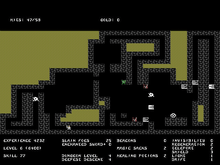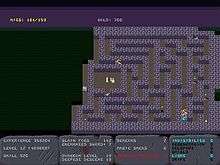Sword of Fargoal
| Sword of Fargoal | |
|---|---|
| Developer(s) | Jeff McCord |
| Publisher(s) | Epyx |
| Platform(s) | Commodore 64, Commodore VIC-20, iOS |
| Release date(s) | 1982 |
| Genre(s) | Adventure |

Sword of Fargoal is a 1982 video game by Jeff McCord, published by Epyx.
Development

Sword of Fargoal was created by author and programmer Jeff McCord and based on his original dungeon adventure, Gammaquest II, which was programmed in BASIC for the Commodore PET computer and written in 1979-1981 while he was still in high school in Lexington, Kentucky. Gammaquest II created randomly generated dungeons that were revealed piece-by-piece as the character explored the map, and stayed "lit" behind the character as it moved, emulating the "mapping" of a dungeon level. The game graphics, however, were limited to the character set of the computer.[1]
McCord accepted an offer to publish the game from the video game developer and publisher Epyx in 1982 on the Commodore VIC-20. His original name for the new version was Sword of Fargaol, deriving the name from the Old English spelling of jail (gaol), but his producer at Epyx, Susan Lee-Merrow, convinced him to change it to its present form.[1]
The following year, with the release of the Commodore 64 (C64), McCord was asked to release a version of Sword of Fargoal for that machine as well. McCord was unable to implement the conversion as it was written in BASIC, and the sprite-based graphics required machine language programming. McCord's friend, Scott Corsaire (then Carter) and Steve Lepisto wrote all the machine language code that was needed so that game would perform fast enough for the C64 version of the game (including the main redrawing of the dungeon levels, clearing of the screen in a spiral pattern effect, monster AI, collision detection, and joystick control).
Sword of Fargoal is a roguelike game, with the player controlling an adventurous warrior attempting to reclaim the "Sword of Fargoal" from the depths of a monster-infested, treasure-stocked, randomly generated dungeon. The Sword is placed randomly somewhere between the fifteenth and twentieth dungeon level. This so-called "Sword Level" also has the unique characteristic of being a randomly generated, twisty maze of single tile-width passages, rather than a conventional dungeon level like the others. This helped make reaching the "Sword Level" an exciting event in the game-play; once the player sees the maze design, they know the Sword is nearby.
Sword of Fargoal is noteworthy for being one of the first microcomputer games to introduce elements later used by so-called roguelike games, such as dungeons that are randomly generated for each session of play, and gave a nod to earlier games such as Colossal Cave Adventure, which was played without graphics on mainframe computers of the day using Unix terminals.
Sword of Fargoal has remained somewhat notorious within C64 fandom as being extremely difficult to win. Due to the random design of the "Sword Level," it is possible that the player may enter it with no way of actually reaching the Sword room, and he or she must exit and return to that level for another chance. Further, once the Sword was claimed by the player, they have exactly 2,000 seconds (33 minutes and 20 seconds) to escape the dungeon by going back through each level, or the Sword would be destroyed by a curse. Of course, since all levels are newly generated when the player returns to them, they must be fully explored to find the correct staircases leading upward, of which there is usually only one per level on this return trip. Complicating matters further was the fact that if the Sword was lost for any reason (such as being stolen by a wandering foe), the player must return to the level he or she originally found the Sword to reclaim it, and the clock did not stop or reset when this occurred.
The game was originally released on computer cassette tape and 5¼" floppy disk formats. An open source remake exists in both PC and Macintosh versions. An iPhone version was also released in December 2009.
Gameplay
In the game, the player controls a warrior who explores numerous dungeon levels in search of the legendary "Sword of Fargoal" artifact. The levels become progressively harder to survive as the player descends deeper and deeper into the dungeon. Each dungeon is covered in complete darkness that illuminates as the dungeon rooms and corridors are explored. When the Sword of Fargoal is successfully found, a clock countdown begins where the player must successfully escape the dungeon without it being stolen before the time expires, or the Sword is lost.
The warrior gains character levels by gaining experience points, which increase the character's fighting ability and hit points, (called Hits), as they progress through the dungeon. There are several items in the dungeon that help the character, which can be found in treasure chests or on slain adversaries.
Combat in the game is controlled by the computer, and the player has no control over how well or how bad their warrior fights. A warrior can flee an attack at any time, unless they fall victim to a sneak attack (which is when a monster engages in combat before the warrior has a chance to move). The warrior can move freely about the dungeon, whereas monsters take intermittently timed steps.
Each dungeon has a number of staircases that go up or down. In the iPhone version of the game, there are even slippery staircases that will move a character down two levels. Because each map is randomly generated, a level the player returns to will not be the same as when they left it. Stairs also provide an entry for wandering monsters that, over time, replace slain ones on a level. In the iPhone version of the game, floors stay the same on a single game, but change when the player dies or starts a new game.
Characters can find bags of gold scattered around the dungeon. The bags can be taken by enemies if they step over them. Gold can also be stolen from the character by humanoid enemies. If those thieves are killed, the gold is returned to the warrior. A warrior can only carry 100 pieces of gold, and Magic sacks must be located that allow the warrior to carry more.
Each dungeon level contains a temple. Every time the warrior steps on a temple, their gold is sacrificed to their deity, which earns additional experience. In the iPhone version, shields the player is carrying will be renewed when they are blessed. If a warrior remains standing on a temple, it acts as a sanctuary where they become invisible to enemies around them.
Chests in the game are both a bane and a boon to the player. Some contain something useful, or contain a deadly trap. Some chests explode, causing damage, and others release crumbling ceiling or pit traps. A player doesn't know, however, if a chest contains a trap or a useful item, and must take a chance of encountering either. Chests can be picked up by enemies if they step over them. There are six spells that can be found in the dungeon.
There are several enemies in the dungeon. In general, "human" type enemies are more dangerous than creatures. Some new monsters appear in the iPhone version of the game, and "human" type enemies also carry (and use) treasure, such as potions. Often the game will describe whether the monster one encounters is strong or weak.
The latest version of the game ported to modern computers allows the player to adjust the settings and difficulty of the game. The player can choose such things as graphics themes and monster behavior. The player can also trade increased skill in combat over hit points, or vice versa.
Reception
Computer Gaming World noted some bugs and inconsistencies with the documentation, but called Sword of Fargoal "an exciting and intriguing adventure game. The graphics are beautifully crafted".[2] Ahoy! called the VIC-20 version "an engrossing adventure-type maze game".[3] The magazine stated that the Commodore 64 version was "nearly addictive", but criticized the lack of a savegame feature. More seriously, it stated that the randomized dungeons removed mapping and solving mysteries, important aspects of adventure gaming, and concluded "This game is so close to its goal, and yet so far".[4]
Computer Gaming World in 1996 listed Sword of Fargoal as #147 on the "Top 150 Best Video Games of All Time".[5] The iOS port has a Metacritic score of 85% based on 6 critic reviews.[6]
References
- 1 2 Official Sword of Fargoal website
- ↑ Wilson, Dr. Johnny L. (July–August 1983). "The Commodore Key". Computer Gaming World. p. 42. Retrieved 31 October 2013.
- ↑ Salm, Walter (March 1984). "VIC Game Buyer's Guide". Ahoy!. p. 49. Retrieved 27 June 2014.
- ↑ Herring, Richard (November 1984). "Sword of Fargoal". Ahoy!. p. 40. Retrieved 27 June 2014.
- ↑ "150 Best Games of All Time". Computer Gaming World. November 1996. pp. 64–80. Retrieved 25 March 2016.
- ↑ http://www.metacritic.com/game/ios/sword-of-fargoal